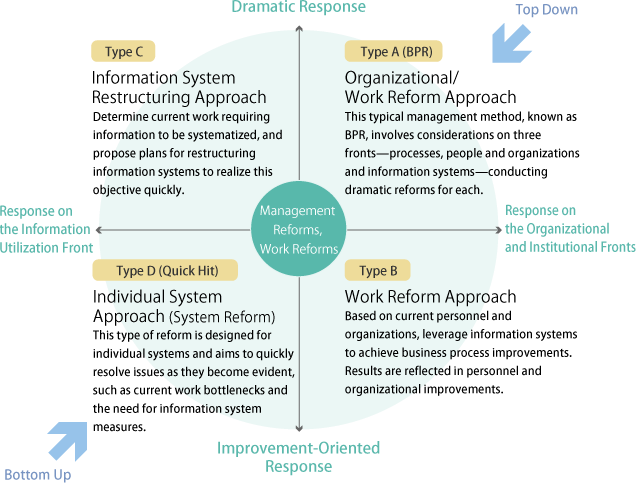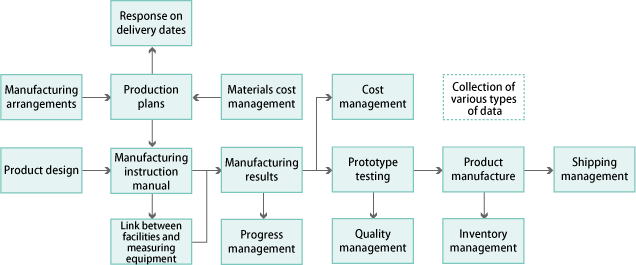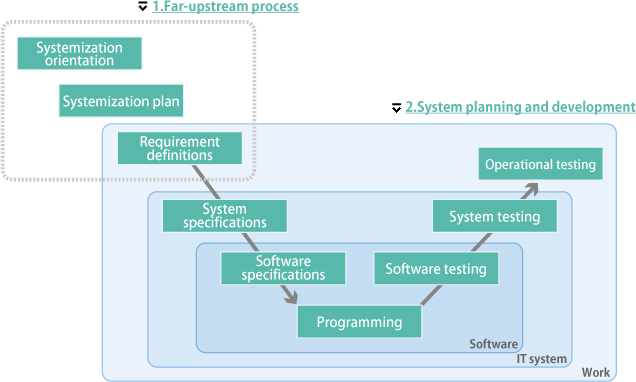Work System Construction
As a system development company familiar with the manufacturing sector, we provide total support ranging from manufacturing optimization to management visualization.
Our Work System Construction Methods
Work systems are employed in operations divisions and in other parts of a company in the execution of business. Generally speaking, as shown in the chart below we examine the orientation of systemization, set up the project and proceed to build a system.
This is known as the "waterfall-type" development process (V-model), and is the standard procedure by which our company applies our development methodology.
1. Far-upstream process
We use our manufacturing work know-how and past project experience to support clients in the "systemization conceptualization phase" to examine goals, functions, means of implementation, aims, summary schedule tasks, etc. of the corresponding themes from the perspective of management.
This planning generally presupposes work reforms.
The simple phrase "work reforms" encompasses a variety of kinds of reform, and our company possesses the project advancement know-how that combines a variety of reforms, as shown in the diagram below.

2. System Design and Development
We typically carry out development projects according to the stages outlined below.
For individual tasks, we apply our standard framework for meetings (sessions) procedures and outputs to conduct projects efficiently.
3. Project Operation and Management
We have set up the Project Management Office (PMO) to support client project managers in such areas as promoting projects, defining policies and running meetings.
Development processes are CMM* compliant, and this expertise is applied to project management.
* Capability Maturity Model (CMM)
A maturity model for the software development process that serves as the standard for development processes.
In 2005, we received level 5 certification, the highest level for this model.
Our Strengths as a Manufacturer-Oriented Systems Company
Over the past several decades, we have developed flexible systems in response to needs of customers in the manufacturing sector in areas such as sales, inventory, purchasing and production management.
In particular, we have accumulated proprietary expertise in the area of production control system configuration, which is key for manufacturers. Based on the expertise we have gained by looking at numerous manufacturing sites of various types, we have in place a large number of personnel who understand manufacturing principles. The resulting ability to propose excellent methods to our clients is one of our company's strengths.
For example, we handle production control systems encompassing a variety of manufacturing for the Furukawa Electric Group, which operates plants that create metals, plastics and other materials; plants that make devices, modules and other precision parts; and plants that make long items, such as electric cables.
In recent years, we have proposed IT systems that meet factories' needs for work reforms and global responses and that maximize their effects. We analyze the issues that each plant faces, and then construct IT systems to improve quality, shorten lead times and reduce costs. In addition to meeting the needs of just-in-time manufacturing, we support the visualization of the information required for management, spanning processes from sales management and product design to cost and inventory management.
Production Control Systems
Our production control systems realize efficiency improvements, reduced staffing requirements and compilation of databases for core systems (sales, purchasing and accounting) and collaborative/staff work (planning, design, site instruction, various management systems)/site work (such as manufacturing and verification results). We also employ various types of data to enable visualization of quality upgrades, customer service improvements, cost reductions and other activities.

For production systems that are not suited to ERP packages, we tailor development systems using modules comprising production control systems that we have accumulated. For production systems suited to ERP packages, in addition to selecting and implementing ERP we build systems that link with peripheral systems.






